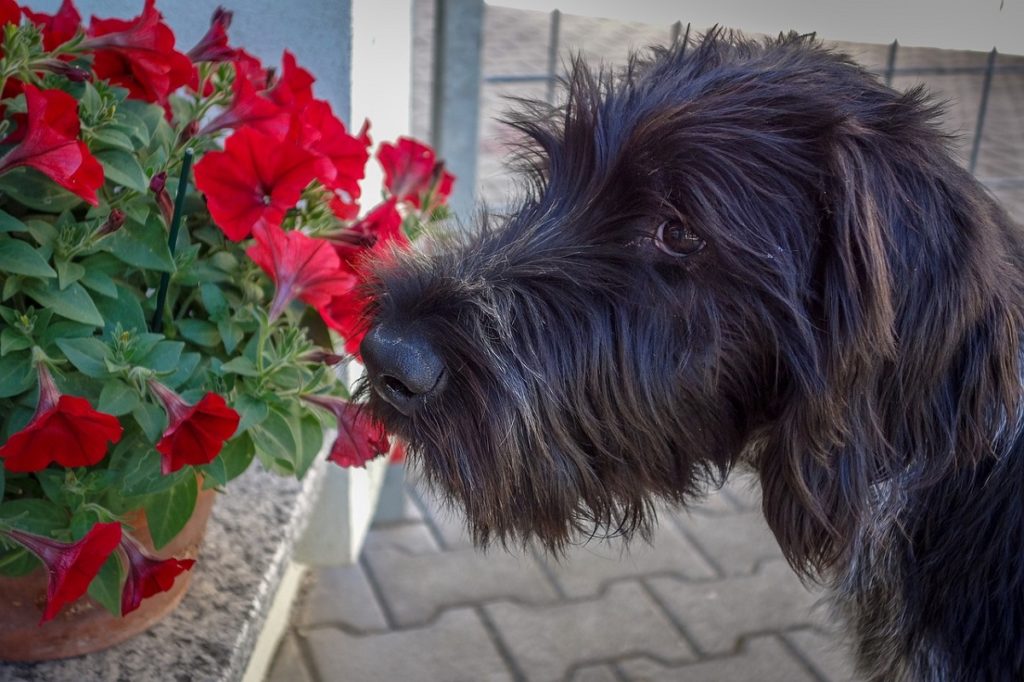Dogs are great pets, but one thing will always be certain about your canine companions: they get into things! And sometimes, these items can cause your dog serious harm.
When it comes to plants that can be found both outside and in your home, there are actually thousands of species of plants and flowers that are considered “poisonous” to your dog. While this is obviously an alarming number, the good news is that only a small percentage of them pose any real danger to your pet.
That being said, it can be a great benefit to you as the pet owner to know at least a few of the poisonous plants to watch out for to make sure your dog stays away from them. Dig through the list below (in alphabetical order) to identify some of the more dangerous poisonous plants to dogs.
The Most Poisonous Plants For Dogs
Amaryllis
The Amaryllis is a beautiful flower that is especially popular around Easter. Unfortunately, its beauty is its greatest deception, as it is highly poisonous to dogs, a theme you will find that is running throughout this list. The toxins in an Amaryllis plant can cause anorexia, canine depression, abdominal pain, hypersalivation, tremors, and even diarrhea and vomiting in dogs.
Unlike some other plants found on this list, consumption usually does not lead to death but can cause very uncomfortable symptoms.
Autumn Crocus
There are actually two Crocus plants: one that blooms in the spring, and another that blooms in the fall. The spring variety is more common and known to cause problems for pets, including canine vomiting and diarrhea in dogs.
Although less common, the Autumn Crocus is much more poisonous, containing colchicine. The Autumn Crocus variety can cause more intense symptoms, such as severe vomiting and diarrhea, and burning sensation in the dog’s mouth, canine seizures, liver and kidney damage, gastrointestinal bleeding, and even respiratory failure.
While the entire plant is considered toxic to dogs, the bulbs contain the highest level of toxicity. You should bring your dog into your veterinarian immediately if you suspect he has come in contact with Autumn Crocus, even if you don’t notice any signs immediately, as they may be delayed for a few days.
Azalea
 Azaleas are highly toxic to dogs, with an ingestion of as little as just a few leaves often causing oral irritation, vomiting, and diarrhea. Azaleas come from the same family as rhododendrons and can even cause your dog to fall into a coma and die in more severe cases. This is another plant for which you need to seek immediate veterinary attention if you suspect your dog has ingested even a tiny amount.
Azaleas are highly toxic to dogs, with an ingestion of as little as just a few leaves often causing oral irritation, vomiting, and diarrhea. Azaleas come from the same family as rhododendrons and can even cause your dog to fall into a coma and die in more severe cases. This is another plant for which you need to seek immediate veterinary attention if you suspect your dog has ingested even a tiny amount.
Cyclamen
Cyclamen is a seasonal flowering plant that has roots which are extremely dangerous to dogs and other animals. Cyclamen can cause severe vomiting and even death if ingested by your dog. Immediate veterinary care will be required.
Daffodils
Daffodils are known dangers to dogs because they contain lycorine, which is an alkaloid that has strong emetic properties, meaning it triggers vomiting. These lovely-looking and smelling flowers can cause your dog to experience intense vomiting, diarrhea, abdominal pain, or even the potential for cardiac arrhythmias if ingested in high quantity.
The bulb, plant, and flower are all toxic to dogs, but the crystals found in the outer layers tend to be the ones that cause irritation and secondary drooling. Symptoms from daffodil ingestions can be quite severe, so immediate veterinary care will be required if you witness or suspect your dog has ingested any of this plant.
Dieffenbachia
Dieffenbachia, also known as “Dumb Cane,” is a popular plant in homes and offices that are highly toxic to dogs. This plant can cause drooling, oral irritation, canine nausea, vomiting, and can even make it difficult for the dog to swallow. While not considered life-threatening except for in the most severe instances, these symptoms will still be difficult for your dog to handle.
Kalanchoe
Another popular plant in homes and offices is the Kalanchoe, which is a flowering succulent with hundreds of dense flowers, ranging in color from yellow to pink, orange, or red. Also known by the names Devil’s Backbone, Mother-of-Millions, and the Chandelier plant, Kalanchoe contains cardiac toxins that cause gastrointestinal symptoms, such as diarrhea and an upset stomach. A large amount consumed can cause a change in a dog’s heart rate and arrhythmias.
Lilies
There are many different varieties of lilies, some of which are harmless to dogs, but others can be quite dangerous. Calla, Peace, and Peruvian lilies all contain oxalate crystals that cause minor irritation in the mouth, tongue, esophagus, and pharynx, that leads to minor drooling.
True lilies are the more dangerous varieties, including Tiger, Easter, Day, Asiatic, and Japanese Show lilies. Small ingestions of these flowers can cause severe kidney failure in dogs, and any animal seen ingesting a lily should be brought in for immediate veterinary care. The sooner you bring in your dog, the sooner he can receive treatment for a poisoning. Lilies also pose a great danger to cats as well.
Foxglove
Another plant that is actually poisonous to animals and humans, this beautiful plant with trumpet-like blossoms can cause severe symptoms, including vomiting, diarrhea, cardiac arrhythmias, heart failure in dogs, and even death.
Lily of the Valley
This subset of lilies causes similar symptoms to foxglove and is thought to be just as toxic. Lily of the Valley can cause your dog’s heart rate to drop and even lead to dog seizures. Immediate medical examination and treatment will be required.
Oleander
Oleander is extremely toxic. The poison in this plant is found in the leaves and flowers. Commonly grown in warm locations, Oleander’s naturally-occurring poison is known to have a serious effect on the heart. Ingestion of this outdoor shrub can result in severe vomiting, slowed heart rate, and even death if left untreated.
Sago Palm
The sago palm is another plant that is very popular in warmer climates and can thrive both as an indoor and outdoor plant. It is entirely poisonous, with the seeds being the most toxic part of the plant. The primary active toxic agent in sago palm is cycasin, which can result in severe liver failure in dogs. It can also cause bloody stool in dogs, vomiting, damage to the stomach lining, and even death.
Minor symptoms may appear almost immediately while the most severe signs will take two to three days to show up. Sago plant poisoning will need to be treated aggressively, and even when caught early, the survival rate for dogs is only around 50 percent.
Tulips and Hyacinths
Tulips are mainly toxic to dogs in their large bulbs, so if you have tulips, you’ll need to make sure your dog isn’t digging them up in your garden. Tulip ingestion can cause your dog to have irritation in his mouth and esophagus, which can be minor to severe, depending how much of the plant the dog was able to ingest. Typically, this poisoning is not fatal, and dogs will respond well to treatment.
Other Plants & Varieties that are Poisonous to Dogs
It’s important to note that this is a very short list of the poisonous plants to dogs. Visit the ASPCA for a more comprehensive list and familiarize yourself with images of these more common culprits so you know the major poisonous plants that are harmful to your dog. It’s also important that you are able to spot the signs and symptoms of poisoning in dogs as well.
 Poisonous plants can be both indoors and outdoors, and come in a wide variety of shapes and sizes. They can be perennial flowers, annuals, vines, bulb plants, tropical plants, shrubs, weeds, trees, and more. Make sure when you are decorating your home and yard that you keep your dog in mind and choose plants that are not poisonous to dogs. It’s also important to note that some household plants are poisonous to cats as well, so be sure to educate yourself on these harmful plants if you have a feline in your home.
Poisonous plants can be both indoors and outdoors, and come in a wide variety of shapes and sizes. They can be perennial flowers, annuals, vines, bulb plants, tropical plants, shrubs, weeds, trees, and more. Make sure when you are decorating your home and yard that you keep your dog in mind and choose plants that are not poisonous to dogs. It’s also important to note that some household plants are poisonous to cats as well, so be sure to educate yourself on these harmful plants if you have a feline in your home.
Safety Strategies to Prevent Plant Poisoning
It’s nearly impossible to keep your dog from getting into everything that could cause him harm, but you can take some steps to help ensure that poisonous plants are not one of them.
For example, even before you get to the plants themselves, you can make sure to keep your dog away when you spray pesticides, store fertilizer in a place your dog can’t reach it, and beware of snail bait, which can all make your dog sick. If your dog has gotten into one of your gardening supplies before, you can be sure they will do it again if given access. Most garden products are safe shortly after they have been applied, but may still cause issues right when they are used, so be sure to keep your dog away until they can safely come in contact with anything you use on your plants or yard.
With regard to your plants at home, consider choosing other varieties that are non-toxic. There are millions upon millions of plant and flower varieties. You can find something similar to a toxic variety that will be safer to have around your dog. Take an inventory of your current garden and consider removing any plants that are known to be poisonous to dogs and replace them with safer options.
You should also make sure you keep up with the maintenance of your yard and garden, as overgrowth can lead to added pest concerns, which can invite ticks and fleas to join the party. Keep up with your plant and yard maintenance to ensure these pests don’t add to your problems.
Make sure you pick up your dog’s feces routinely rather than letting it pile up as this can also create a less-than-healthy environment and build up of bacteria in your yard.
And while you can’t control what elements are out in nature if you take your dog for a walk in your neighborhood, to the local park, or on a hike, you can help stop them from getting into trouble with plantlife by knowing what some of the most common poisonous plants look like.
Summary
There are thousands of poisonous plants to dogs, far too many for any owner to keep track of, but knowing the few to watch out for that you are likely to see can help prepare you. Should you ever suspect that your dog has ingested something toxic, whether from the garden or in the wild, seek the guidance of your veterinarian immediately. Toxicity from some plants can be treated easily, while others can lead to a life-threatening situation.
Sources:
“Ten Common Poisonous Plants for Dogs.” PetMD, Accessed 4 Nov. 2018. www.petmd.com/dog/slideshows/emergency/poisonous-plants-to-dogs.
“Plants Poisonous to Cats – Poisonous Plants for Dogs.” Pet Poison Helpline, Accessed 4 Nov. 2018. www.petpoisonhelpline.com/pet-owners/basics/top-10-plants-poisonous-to-pets/.
“Poisonous Plants.” ASPCA, Accessed 4 Nov. 2018. www.aspca.org/pet-care/animal-poison-control/toxic-and-non-toxic-plants.




